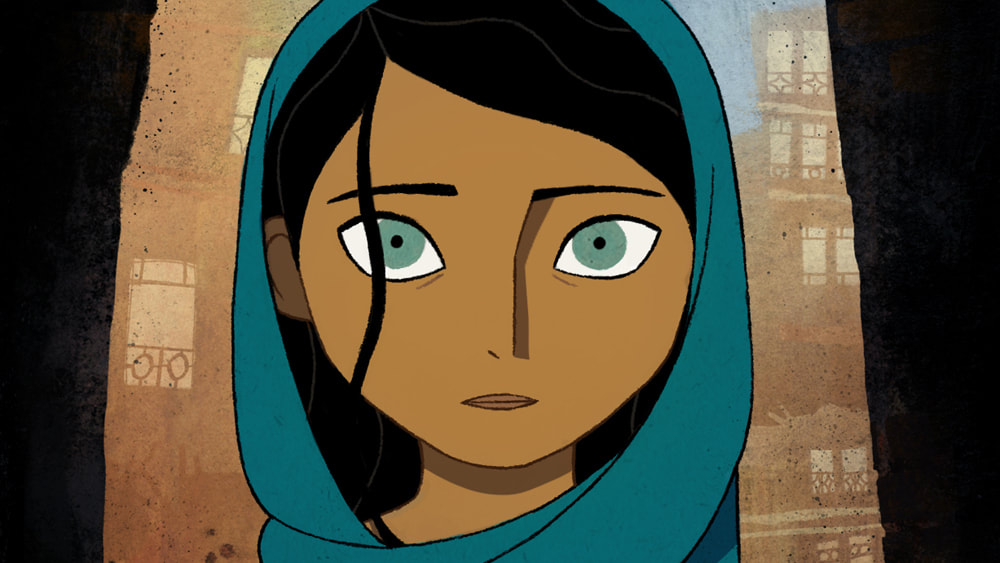‘Let's get this guilt’: Exorcising white guilt at ‘The Breadwinner’by Nash Croker At the end of my first month in America, on a whim and a 3-month-old recommendation, I headed down to BAMPFA for an all-age matinee showing of The Breadwinner (2017). Nora Twomey’s adaptation delivered a beautifully animated tale of humanity in the face of brutal hardship. A story, mirrored by its own childlike meta-narrative, of a young Afghan girl (Parvana) who dresses as a boy to care for her family when her father is arrested by the Taliban.
For a story so obsessed with the power of storytelling, however, it was only upon hearing the theatre erupt in applause upon its conclusion that the political role of its own story became apparent. Deborah Ellis, the author of the book the film is based upon, is a white Canadian woman. Nora Twomey, the director of the film, is a white Irish woman. Angelina Jolie, a celebrated white American actor and filmmaker, is an executive producer of the film. The audience with whom I watched the film were predominantly white students of an American Public University. To state these facts is not to condemn these people for their whiteness, their gender, their nationality or their relationship to the production of the film. Instead, it is to locate the production and reception of this story in structural power relations. As soon as its storybook visuals unfurl the first thing to notice about The Breadwinner is the language. With no subtitles and only a scattering of Arabic, The Breadwinner is fully voiced in English by a cast of largely migrant-Canadian actors of colour. This choice immediately asserts that the film and this story are for a Western audience. Unashamedly, The Breadwinner is a film about brown people, made by white people for white people. As such, the power relations between the film’s subject and its intended audience are central to the production and reception of the story. The story is one of persevering humanity and acts of love in the face of devastating material hardship. Yet the causes of this material hardship are intentionally left unexplained. So much of The Breadwinner is about the power of storytelling, and it is through the artifice of storytelling that the film simplifies and obscures the ‘real-ness’ of this fictional version of reality. Even as a cinematic adaptation of a young adult novel the simplicity of its storytelling and eradication of Western intervention in Afghanistan is so severe as to question its political motivation. Kabul’s decline and the rise of the Taliban is left explained only by ‘an invasion’ and civil war in Parvana’s father’s story. This simplified tale is not for her, but for the white Western audience. The childlike frame of reception evades any notion of Western influence for the material hardship our protagonist finds herself in. There is no exposition of the CIA’s arming and financing of the Mujahideen during the Soviet invasion, or the ongoing war in Afghanistan preceded by the US invasion in 2001. Instead, the ‘war’ that breaks out near the film’s conclusion is left woefully unexplained. The plot itself is also mirrored by Parvana’s own tale, told to her younger brother, of a boy determined to overcome an ‘evil mountain elephant’. This use of meta-narratives to augment the main story highlights the film’s own political role in providing a naive simplification of decades of Western intervention in Afghanistan and the Middle East. So much as Parvana treats her brother to a storybook retelling of the plot, The Breadwinner treats its audience to a guilt-free moralising tale of human hardship. Furthermore, as a review of the film in Variety magazine asserts, it is not only through simplified meta-narratives, but through the use of animation that The Breadwinner avoids confronting the human reality of its subject. “If “The Breadwinner” were a live-action film, it would be virtually unbearable to watch, but as animation, it’s not only possible, but somehow inspiring to immerse oneself in this pared-down adaptation of Deborah Ellis’ well-regarded young-adult novel” (Variety, November 2017). Not only does the animation mask the real human face of its fictionalised subject, but combined with a use of English language the white Western audience does not confront a real life Afghani population. In its own way, the animated, voice-acted characters in The Breadwinner are a Westernised fictional creation, substituted for the actual faces of this material hardship. Ultimately, it is only upon witnessing the audience’s own collective reaction to the film that its political machinations become apparent. So much as the animated characters are meant to mask the human Afghani subject, they allow the Western audience to better empathise and see themselves on screen. Not only does the film’s title apply a Western capitalist conception of gendered division of labour, but it takes a markedly Western feminist portrayal of Muslim women’s experience of the burqa. For 94 minutes then, the audience is immersed in an albeit sanitised experience of material hardship. Upon its conclusion, the clapping that follows does not serve to thank the producers and cast of the film for their art. Instead the only witness to the applause are other cinema-goers. To clap at film then is a self-serving act, one that signifies one’s own appreciation and public reputation in relation to the film. Applied to the veritable de-politicised story of The Breadwinner, the audience applause serves to both show the personal importance of having experienced this tale of hardship while simultaneously pulling them out of it, reasserting their privileged status as beneficiaries of the violence to which this material hardship owes its construction. In essence, the political role of The Breadwinner’s story is a cathartic exercise of white guilt. It is the audience’s realisation of this that is expressed in its applause.
0 Comments
Leave a Reply. |
Archives
March 2024
Writers
All
|
